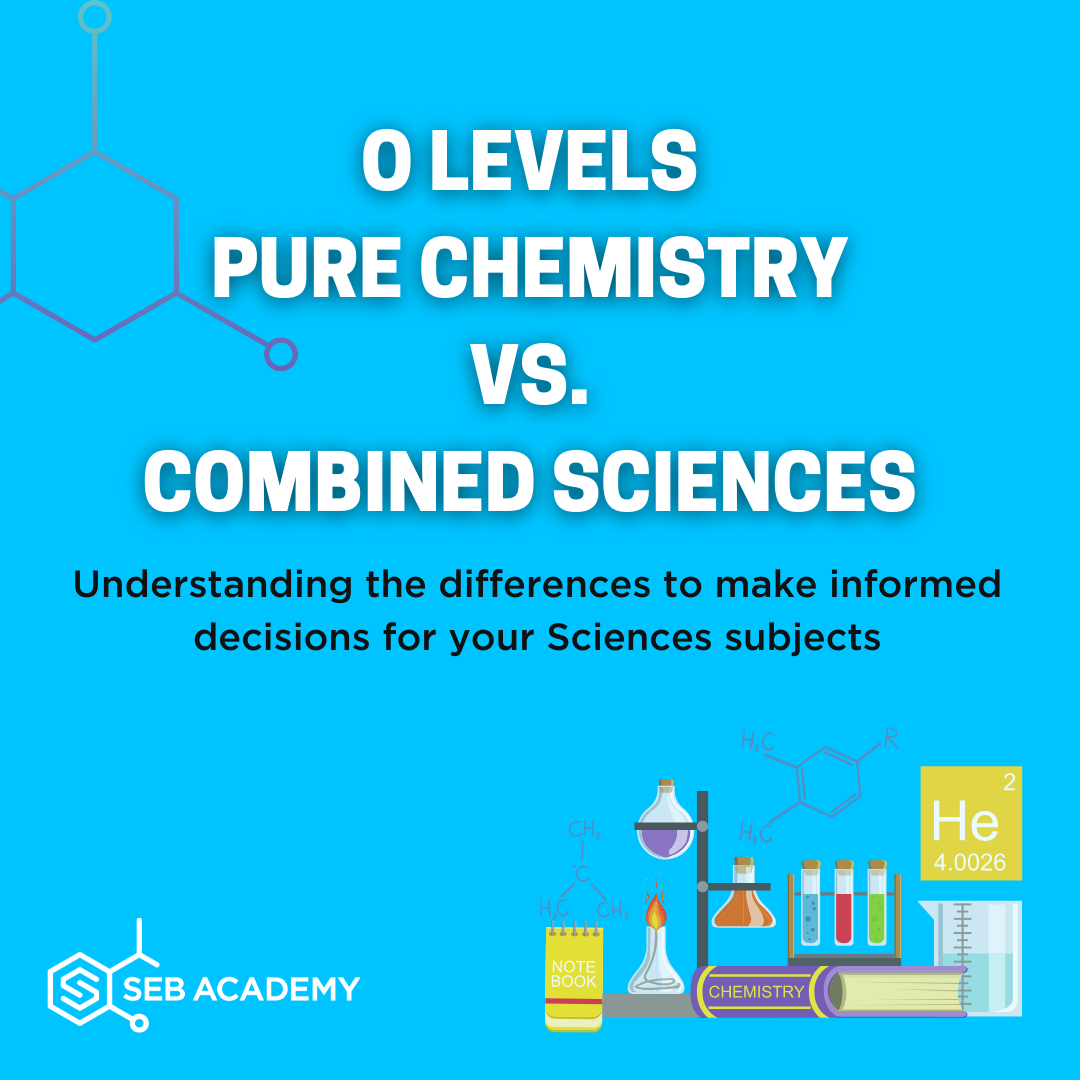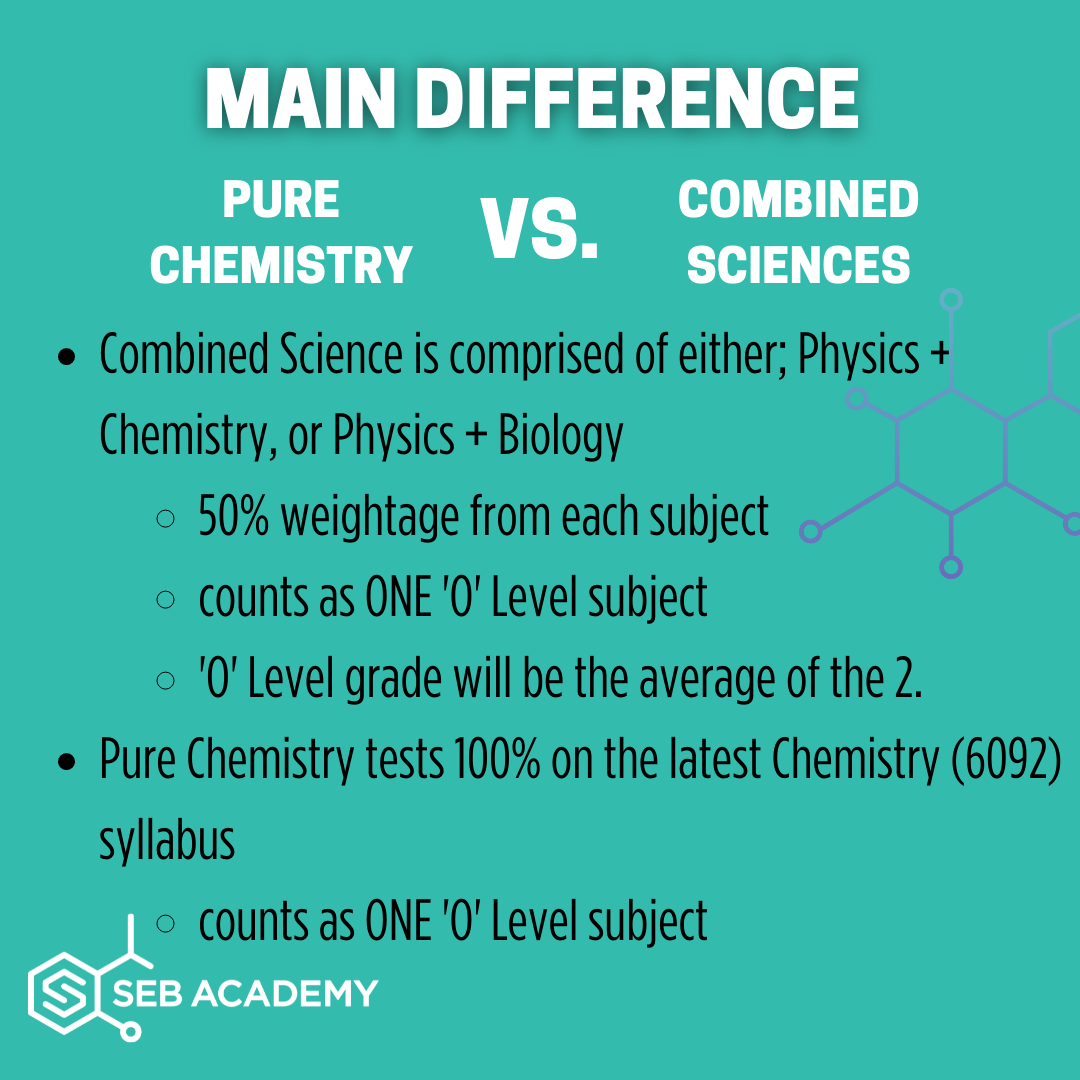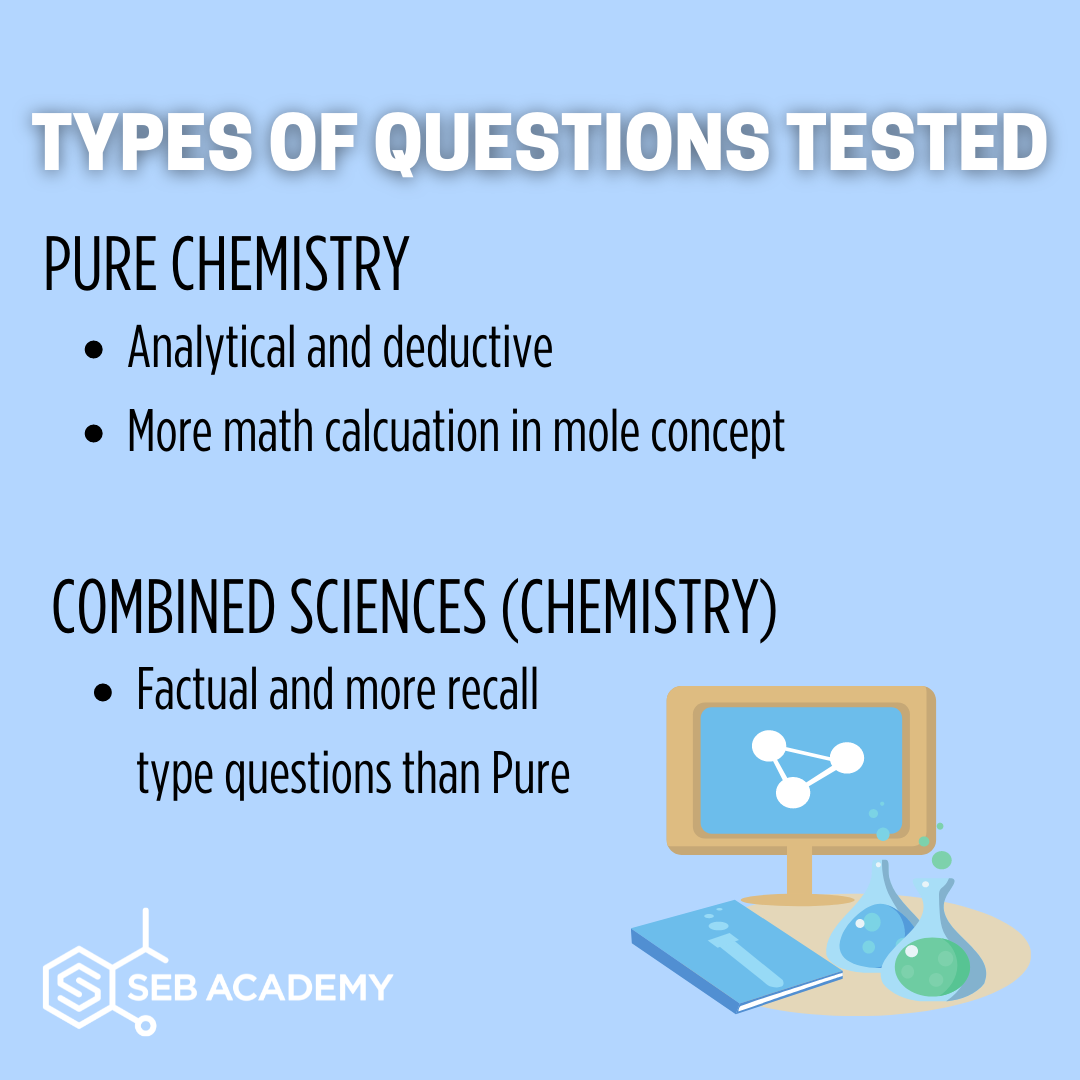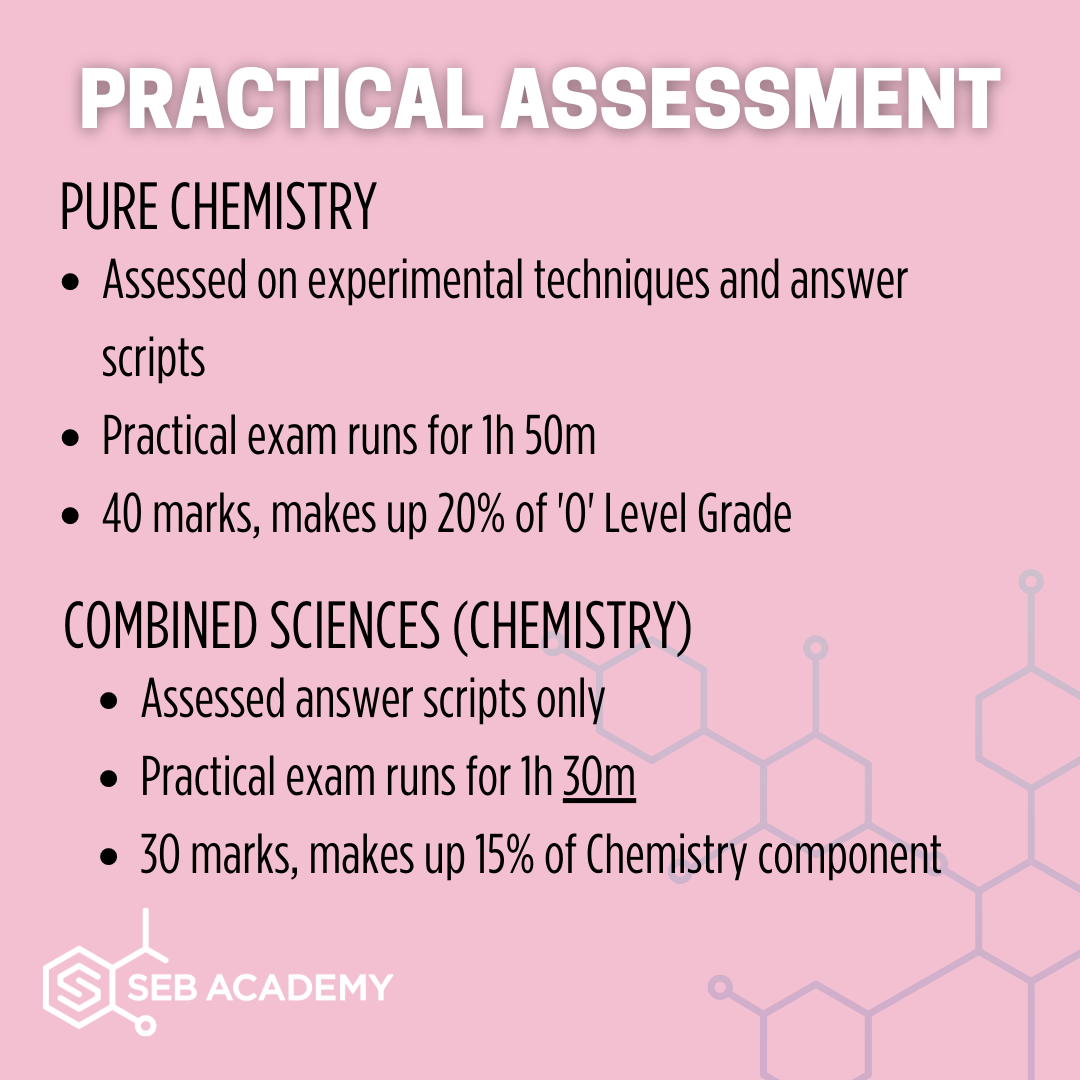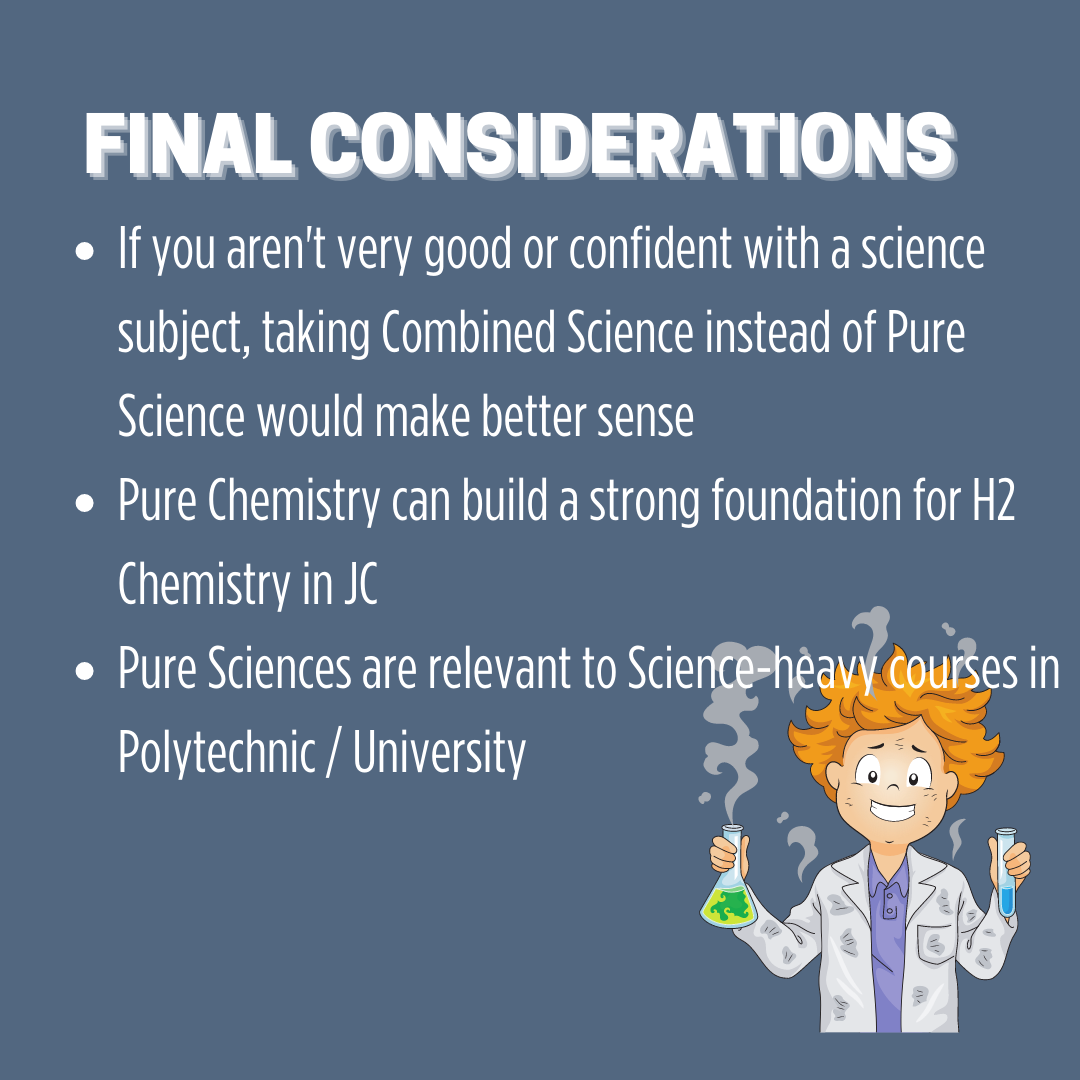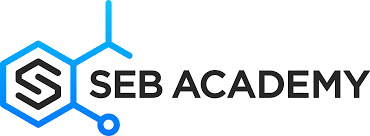
The main difference between O Level Pure Chemistry and Combined Sciences
It’s actually very simple. O Level Pure Chemistry consists of Chemistry as an entirely separate, individual subject for your O Level examinations. The syllabus matter will consist of the entirety of the latest Chemistry syllabus (6092) and your examination will be based on this. In Combined Science however, this is not the case: you will be studying 50% Chemistry and 50% of another Science stream subject such as Physics or Biology instead. This combination will also count as a single O Level subject, and the candidate will no longer sit for two separate Pure Science O Levels (for example, Pure Chemistry and Pure Physics) and will instead sit for one combined exam that will have 50% of Chemistry and 50% of Physics (or vice versa).
Assessment differences between O Level Pure Chemistry and Combined Sciences
Academic Results:
Therefore, the fundamental difference between Pure Chemistry (and Pure Physics) and Combined Sciences subjects is that in Pure Chemistry, you’re able to sit for two O Level Exams (Pure Chemistry and Pure Physics) and have 2 results in your result sheet, and for the latter, which is Combined Sciences, you’ll be sitting for just the one. The grades in Combined Science are as the name suggests, combined. For example if you receive an A1 in the Chemistry Section of Combined Sciences Chemistry and C6 in the other division, Physics section, combined your grade will average a B3/4. If these were two Pure Science subjects though, you would receive two separate grades: an A1 for Chemistry and a C6 for Physics. A drawback of this is obviously a reduced number of O Level subjects – but, more on that later. Below, we’ve listed the other key differences between the two:
Type of Questions Asked for O Level Pure Chemistry and Combined Sciences
- Pure Chemistry papers tend to have more analytical questions than combined sciences papers. It tests heavily om deductive type of questions. You will need to spend more time analysing and think faster to get the results. As for combined sciences, the assessment criteria is based more on factual questions and recall. Also, Pure Chemistry generally cover more topics than that of combined sciences and there are a lot more math calculations in mole concept involved.
Marking Criteria for O Level Pure Chemistry and Combined Sciences
- In the pure science practical exams, the students are marked both on their experimental techniques as well as their answer scripts. In Combined Science, you’re marked only based on your answer script, though numbers do tend to decrease if you ask for help.
Scope of Assessment
- Though the questions in Combined Sciences tend to be a little easier so that students dropping from Pure Chemistry can cope better, the Combined Science segment still has more content for one subject for much less credit. You are studying up to 80% of the Chemistry syllabus, and double the effort because you have to study for Physics as well but only obtain results for 1 academic subject.
Topics omitted in the Combined Sciences (Chemistry) Component which are in the O Level Pure Chemistry:
- Electrolysis
- Simple Cells
- Organic Chemistry (Esters and Macromolecules of polyesters)
Combined Science is offered to students who are not very good or interested in the science subjects and have an aptitude elsewhere; a student who is doing well in their exams will be suggested to stick to Pure Sciences.
Practical Papers for O Level Pure Chemistry and Combined Sciences
- The Practical assessment type is different in both of these as well. Pure Chemistry students have to go through a full 1 h 50 minutes worth 40 marks. The total weightage of the Practical Paper for Pure Chemistry is 20% for the O Level Chemistry Syllabus 6092. For Combined Sciences students, on the other hand, they are given only one Assessment known as Paper 5 in 1 h 30 minutes worth 30 marks. The Practical is based on the Physics and Chemistry component of the Paper.
What Should You Do?
Before making the decision to switch from Pure Chemistry to Combined Sciences – Chemistry, there are several questions you need to ask yourself. First of all, how good are you at Chemistry? Are you getting an A1 in the mocks of the subject? Do you want to work in a field that relies heavily on the subject in the future? Second, ask yourself how good you are in the combination subject, that is, the Physics component or maybe Biology. The main attraction behind the Combined Sciences Chemistry subject is that you get to drop a science subject you’re terrible at and won’t have to show its grade. So if you’re grade is very poor in one, then it makes sense to make the switch to Combined Sciences Chemistry instead of taking Pure Chemistry. This is a litmus test for you if you are doing very badly for the examinations (average 40-50% for all your subjects): if you are going to do badly, it is a strong encouragement for you to drop your pure sciences to focus on other subjects and do better for combined sciences. Afterall, JC may not be suitable for you as it will be more academically rigorous than O Levels, and your goal now is to secure the best L1R4 you can achieve to accelerate to a good polytechnic course you can apply to and do well in for tertiary education such as university.
One important short term goal that can help you is: Would you be pursuing H2 Chemistry at JC? If so, taking Pure Chemistry is a better option as it will train you up to deduce and analyze questions more efficaciously for the exams, instead of the O Level Combined Sciences Paper. Do note that the short term ‘suffering’ of taking O Level Pure Chemistry will pay off for the long term goal of securing a good base and foundation for the A Level H2 Chemistry program and help you secure a good base to score the best points you can for university!
Another thing to keep in mind is the demand of the Combined Sciences (Chemistry) subject especially in Singapore. Since the number of your O Level subjects is decreasing, a combined course will make it more difficult to secure a spot at JC / Polytechnic courses. That is why, you should carefully consider what you want to do because the decision can very much effect your future.
To conclude, there are a myriad of differences between Pure O Level Chemistry and Combined O Level Chemistry with unique benefits and drawbacks in each. Carefully go through each of them and take some time to think about your own situation before coming to a decision.
Seb Academy Tuition Centre specialises in teaching O level Chemistry, A Level Chemistry to secondary school and JC students in Singapore. Our tutors deliver results consistently through engaging lesson plans, encouragement and constant follow-ups with their homework to ensure learning is on track to their A! Our O level Classes & IP Classes provides a comprehensive package for understanding chemistry concepts for the O Level Syllabus. The Program is rigorous and would provide a seamless transit for students looking to further tertiary education at A Levels H2 Chemistry or polytechnic courses. Also, do check out our new lower secondary classes offered! Seb Academy also offers virtual classes and a full fledged student’s portal where you can access a resourceful library of curated lectures, mini lectures, assessment and key answering shortcuts to help you to secure your A! Our Sec 3/4 Classes are helmed by Mr Sebastian Lim and Ms Sera, and Mr Sam Lee heads the A Level Chemistry Tuition Class division. Do read our interesting articles on our blog page for other content on academics, exam insights, Chemistry in every day lives. If you want to find more about our classes, do contact us today for more information!
